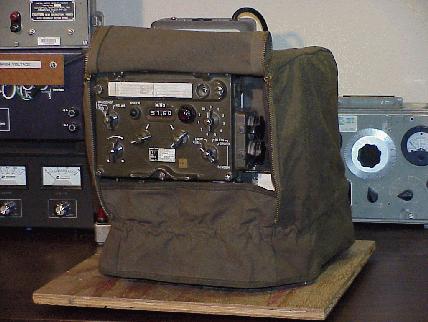
Please note that I do not have any original manuals for this set, and I do not even have a complete set of copied manuals (for example, I do not have any aligment procedures, and I would have great difficulty understanding them even if I had them due to my very poor command of the German language). I cannot provide any further information beyond what is described here at this time, and I cannot provide manual photocopies or other printed information at this time. This page truly contains everything I know about the SEM-25!
Please comment me if you discover any errors in this paper.
I hope you find this information useful!
Description
The SEM-25 is a West German short-range tactical vehicular VHF FM transceiver which was introduced in the 1960’s, and was apparently used until at least the 1980’s. Although surplus SEM-25 radios are not yet very common in the U.S., some have recently appeared on the U.S. surplus market from vendors such as Murphy’s Surplus Warehouse.
The SEM-25 covers 26.00 to 69.95 MHz, in 50 kHz steps. It is all solid-state, except for three tubes in the transmitter power amplifier. A SEM-25 system will typically consist of at least the following items:
- Transceiver chassis
- Control box (may be mounted on front of transceiver, or remotely)
- Mounting/power supply
- Power transient suppressor
- Antenna tuning unit
- Antenna
- Audio accessories ranging from a simple handset to several junction boxes and headsets
- Various cables
More complicated systems may consist of two SEM-25 transceivers and one EM-25 receiver, with lots of audio gear and cabling, thus providing a set with retransmission and intercom features.
So far, I have only obtained a transceiver chassis, control box and mounting, so I cannot provide much information about the antenna, antenna tuning unit, power surge protector or other accessories at this time. The audio connections on the control box and main chassis are compatible with common 1950’s U.S. audio accessories such as the H-33/PT handset and LS-166/U loudspeaker. Pictures I have seen of the correct German audio accessories (well, actually photocopied photocopied photocopies…) suggest that the correct German handset (called an H-33G) appears virtually identical to its U.S. counterpart, and the correct loudspeaker has a case like a U.S. LS-7 loudspeaker with a mounting like a U.S. LS-166. The headset looks a lot like a U.S. H-63/U with an AN/GSA-6 control box. The antenna whip elements are called MS118AK, MS117A and MS116A, and look very similar to U.S. elements with similar names, and the antenna base looks a lot like the U.S. MP-65. The knobs on the control box look just like 1950’s U.S. knobs. I’m really surprised at the similarities between this set and comparable U.S. sets, in spite of the fact that they were designed and built in different countries.
I first learned of the existence of the SEM-25 when I saw a pile of them on the shelves in the famous back room of Murphy’s shop in late 1998. Although I had never been very interested in foreign military gear before, the SEM-25 looked like a neat radio, so I talked my folks into getting me one for Christmas in 1998. My dad and I made the hour-long drive down to Murphy’s shop on Christmas Eve, and I picked out the nicest-looking radio from the pile. It was even gift-wrapped in a stylish olive drab canvas cover!
At the time, Mike was charging $350 for the SEM-25, and $250 for a smaller but similar-looking radio which he called a “SEM-20”. The smaller radio is actually an EM-25 receiver; it’s basically a receive-only version of the SEM-25. It’s easy to get confused about the features and identification of these two radios, because they both use the same control box and share many modules, so the EM-25 is prone to have stickers which say “SEM-25” (or even “SEM-35”; it shares two internal modules with the SEM-35 backpack transceiver) on and inside it, and it will have controls for transmitting functions which it does not perform.
The “SEM” in “SEM-25” is short for “Sender-Empfangsgerät”, which is German for “transmitter-receiver”. Similarly, the “EM” in “EM-25” is short for “Empfangsgerät”, which is German for “receiver”.
Specifications
General
| Modes | Simplex, retransmit |
|---|---|
| Frequency range | 26.00-69.95 MHz |
| Channel spacing | 50 kHz |
| Number of channels | 880 |
| Channel selection | 44 1-MHz bands, 20 50-kHz channels each |
| Programmable channels | 10 |
| Modulation | FM |
| Operation, including frequency selection | Operated from a transceiver-mounted control box, or from a relocatable control box in vehicle (max. cable length 10m) |
| Transmitter operation |
|
| Remote input and output arrangement | From telephone remote control over field phone wires, up to 3 km long, max. resistance 480 ohms |
| Temperature range | Operating range from -45°C to +60°C |
| Overvoltage protector | For transients up to 65V from the battery regulator |
| Power supply | 24V battery supply, negative ground, permissible voltage range 21V to 29V, short term overvoltage up to 32V |
Transmitter
| Output power | High: 15 W Low: approx. 1 W |
|---|---|
| Calling frequency | 1600 Hz |
| Audio input |
|
| Warm-up time | approx. 30 seconds |
Receiver
| Sensitivity | <= 0.5 µV for 20 dB s/n with 1000 Hz modulation and 10.5 kHz deviation |
|---|---|
| Bandwidth | >= 30 kHz at 6 dB points |
| Selectivity | +/- 50 kHz at 80 dB points |
| Audio output |
|
Power Supply
| Voltage | 24V battery (21V to 29V), negative ground, permissible short term overvoltage up to 32V |
|---|---|
| Power requirements, RX | approx. 10 W |
| Power requirements, TX Low | approx. 50 W while transmitting |
| Power requirements, TX High | approx. 80 W while transmitting |
| Power requirements, TX Low or TX High | approx. 29 W when not transmitting |
Sizes and Weights
| Item | Height (mm) | Width (mm) | Depth (mm) | Weight (kg) |
|---|---|---|---|---|
| Control box | 174 | 228 | 75.5 | 2.54 |
| Transceiver | 222 | 268 | 255 | 14.59 |
| Transceiver mount | 120 | 320 | 300 | 9.43 |
| Receiver | 222 | 196 | 255 | 11.08 |
| Receiver mount | 120 | 320 | 230 | 6.68 |
| Antenna tuning unit | 122 | 290 | 110 | 3.70 |
| Overvoltage protector | 93 | 250 | 126 | 2.62 |
| Spares case | 48 | 140 | 140 | 0.73 |
Controls
This section decribes the functions of the controls on the SEM-25 control box.
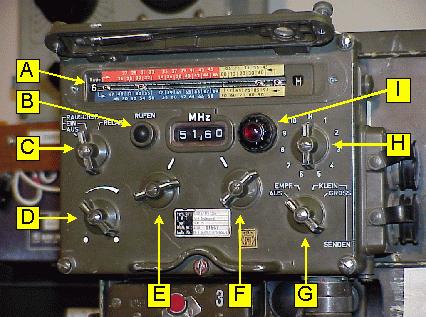
| Ref. | Description |
|---|---|
| A | Channel programming drum (behind cover) |
| B | Call button: Keys transmitter, sends 1600 Hz tone |
| C | Squelch |
| D | Volume |
| E | Manual tuning, 1 MHz steps |
| F | Manual tuning, 50 kHz steps |
| G | Power |
| H | Channel selector (H = manual tuning) |
| I | Power-on light (turn bezel to dim) |
Power Switch Settings (Ref. G)
| AUS: | Off |
|---|---|
| EMPF: | Receive-only |
| SENDEN KLEIN: | Transmit/receive (low power) |
| SENDEN GROSS: | Transmit/receive (high power) |
Squelch Switch Settings (Ref. C)
Note: Squelch is opened by carrier level, equivalent to “old” mode in U.S. radios.
| RAUSCHSP. AUS: | Squelch off |
|---|---|
| RAUSCHSP. EIN: | Squelch on |
| RELAIS: | Relay (retransmit) |
Connectors
This section describes the functions of the external connectors on the SEM-25.
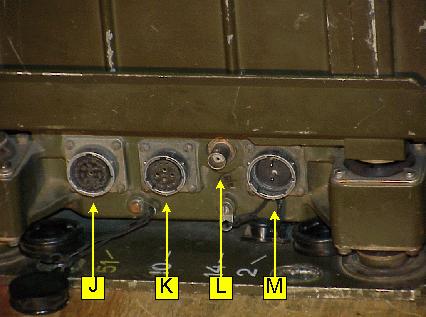
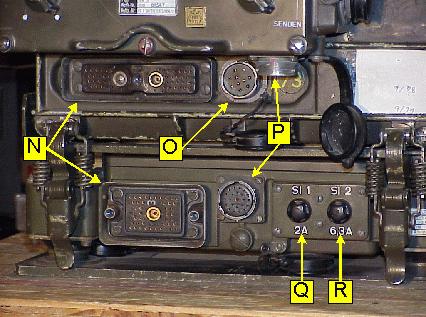
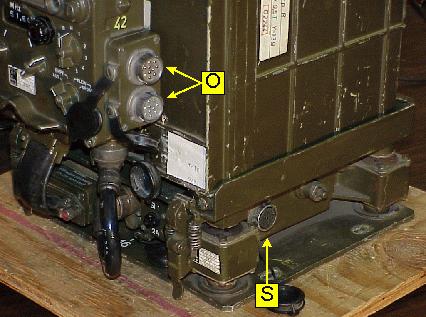
| Ref. | Description |
|---|---|
| J | From transceiver #1 in multi-radio sets |
| K | Antenna tuner control |
| L | Antenna RF |
| M | Power input |
| N | Mounting/transceiver interconnect |
| O | Audio |
| P | Control box/mounting interconnect |
| Q | Receiver fuse (2A) |
| R | Transmitter fuse (6.3A) |
| S | To transceiver #2 or aux. receiver in multi-radio sets |
Modules
This section identifies the SEM-25’s major internal modules. Note that two of the modules (as noted below) are also used in the SEM-35 backpack/vehicular transceiver.
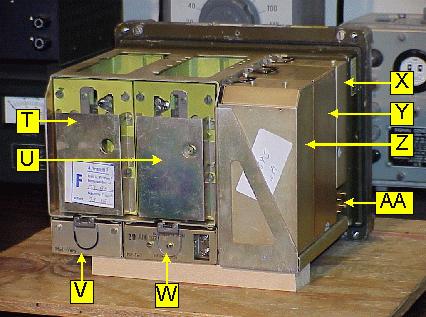
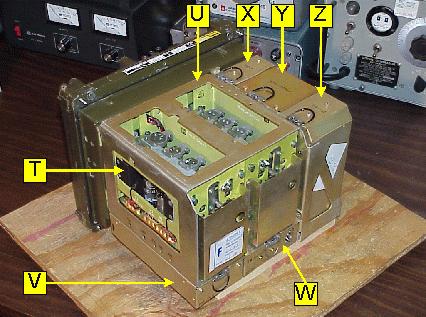
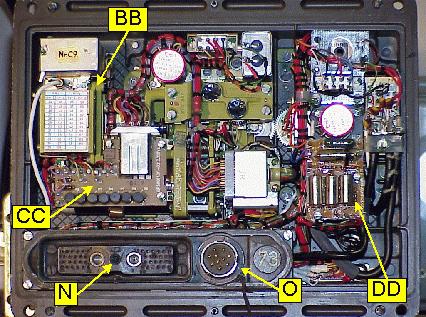
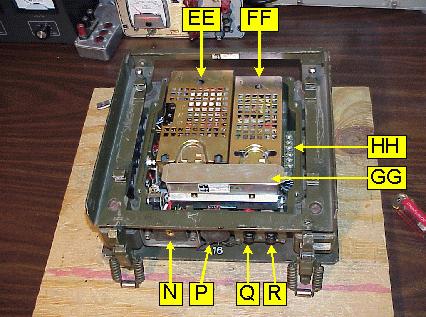
| Ref. | Description |
|---|---|
| N | Mounting/transceiver interconnect (external) |
| O | Audio connector (external) |
| P | Control box/mounting interconnect (external) |
| Q | Receiver fuse (2A) (external) |
| R | Transmitter fuse (6.3A) (external) |
| T | Transmitter RF |
| U | Receiver RF |
| V | Modulator amplifier, 1600 Hz tone generator, and 11.5 MHz discriminator for automatic frequency control (AFC) of transmitter |
| W | Audio amplifier |
| X | Receiver power supply and control amplifier |
| Y | Frequency synthesizer (also used in SEM-35) |
| Z | IF (Intermediate Frequency) module (also used in SEM-35) |
| AA | Plugs for test box |
| BB | 10-frequency crystal oscillator |
| CC | Receiver servo |
| DD | Transmitter servo |
| EE | Transmitter power supply |
| FF | Motor drive power supply for external antenna tuner |
| GG | Relays for interconnect of multiple transceivers |
| HH | 600 ohm balanced audio connections |
Internal Adjustments
While we have the case open, here are some of the major internal adjustments:
| Control | Label | Location | Function |
|---|---|---|---|
| R36 | Rauschperre | Audio amp. (Ref. W) | Squelch level |
| R5 | NF-Pegel | Audio amp. (Ref. W) | Audio level |
| R13 | Eing. | Mod. amp. (Ref. V) | Mod. amp. input gain |
| R26 | Ausg. | Mod. amp. (Ref. V) | Mod. amp. output gain |
| R38 | Tacho | Rx power supply (Ref. X) | Stepping speed trim (?) |
Schematics
The diagrams in this section were scanned at 150 pixels per inch, and you will probably need to use an external graphics-editing program to print them (simply clicking your browser’s “Print” button probably won’t work well).
The diagrams were all scanned from photocopied manuals, and the originals are just as blurry as the scans, so don’t bother asking for photocopies of the schematics! :-)
Block Diagrams
| Description | File | Size |
|---|---|---|
| Transceiver | blk01.gif | 1100×1338, 33k |
| Frequency selection | blk02.gif | 1100×1540, 44k |
| Receiver | blk03.gif | 1172×946, 20k |
| Transmitter | blk04.gif | 1082×888, 12k |
| Antenna tuner (external) | blk05.gif | 948×1240, 15k |
Schematic Diagrams
The “Ref.” column shows the corresponding reference letters from the module identification pictures (where applicable), to help you figure out which part of the radio is described by each schematic.
| Description | Ref. | File | Size |
|---|---|---|---|
| Wiring (main chassis) | — | sch01.gif | 1744×1232, 90k |
| Transmitter RF | T | sch02.gif | 1744×1232, 70k |
| Receiver RF | U | sch03.gif | 1744×1232, 70k |
| Modulator amplifier module | V | sch04.gif | 1744×1232, 62k |
| Audio amplifier module | W | sch05.gif | 1744×1232, 55k |
| Receiver power supply module | X | sch06.gif | 1744×1232, 66k |
| Frequency synthesizer module | Y | sch07.gif | 2381×1231, 117k |
| IF module | Z | sch08.gif | 2539×1232, 84k |
| 10-freq. crystal oscillator | BB | sch09.gif | 1193×768, 17k |
| Receiver servo | CC | sch10.gif | 1196×778, 38k |
| Transmitter servo | DD | sch11.gif | 1172×809, 19k |
| Control box | — | sch12.gif | 3042×1226, 104k |
| Wiring (mounting) | — | sch13.gif | 1744×1232, 94k |
| Transmitter power supply | EE | sch14.gif | 778×1159, 36k |
| Motor drive power supply | FF | sch15.gif | 1187×772, 26k |
| Interconnect relays | GG | sch16.gif | 1197×794, 36k |
| Transient protector (external) | — | sch17.gif | 1201×790, 34k |
| Antenna tuner (external) | — | sch18.gif | 1744×1232, 68k |
English/German Translations
This section lists rough translations of some German words, phrases and abbreviations as used in the SEM-25’s schematics, module labels, etc. My command of German is very poor, so there may be mistakes here… please comment if you can correct any of my translations!
- Abstimmgerät
- Radio tuner (tune + apparatus)
- Abstimmteil
- Radio tuner section (tune + part)
- Additionsstufe
- Addition stage
- Anschluß
- Connection
- Antennen
- Antennas
- Antrieb
- Drive, driver, motor
- Ausgang
- Output
- Bausteinträger
- Component carrier
- Bauteile
- Components
- Bedien
- Control head
- Begrenzer
- Limiter
- Blockschaltbild
- Block diagram
- Bordbatterie
- On-board battery
- Bordverstärker
- Intercom (on-board + amplifier)
- Diskriminator
- Discriminator
- Eingang
- Input
- Einsatz
- Part, component
- Empf.
- Receive or receiver
- Empfänger
- Receiver
- Endstufe
- Output stage
- erdfrei
- Balanced (i.e. “balanced line”; literally, “ground-free”)
- Frequenzaufbereitung
- Frequency synthesizer
- Funk
- Radio
- geschlossen
- Closed
- gezeichnet
- Drawn
- gross
- Large
- Grundplatte
- Mounting (base + plate)
- HF
- Radio frequency (RF)
- Hinweis
- Note
- im
- In
- Kanalwahl
- Channel selection
- klein
- Small
- Leitung
- Line, wire
- Ltg.
- Line, wire
- Masse
- Common, ground
- Mischstufe
- Mixer
- Netzgerät
- Mains power adapter
- NF
- Audio frequency
- Oberton
- Overtone
- offen
- Open
- Oszillator
- Oscillator
- Prüfgerät
- Test meter
- quarz
- Quartz
- rauschperre
- Squelch (noise + stop)
- relais
- Relay, retransmit
- rufen
- Call
- ruhezustand
- Off-state
- senden
- Transmit
- Sender
- Transmitter
- Servoverstärker
- Servo amplifier
- Steuerverstärker
- Servo amplifier
- Stromversorgung
- Power supply
- Teil
- Part
- Transientschutz
- Transient protector
- Treibertufe
- Driver stage
- Trennstufe
- Divider stage
- Umwandler
- Converter
- Verstärker
- Amplifier
- Vorstufe
- Input stage
- ZF
- Intermediate frequency (IF)
Credits
This work would not have been possible without the generous assistance of the following people:
Pictures were taken with a Sony MVC-FD91 digital camera. Reference letters were added with Visio 4 on a Windows NT box; all other image editing was performed with xv and gimp on a Redhat Linux system.
Scanned documents were scanned with a Umax Astra 1220S scanner and the SANE software under Redhat Linux, and then edited with xv and gimp.
Is it possible to retune the SEM25/35 and/or the AGATE to go up to 73MHz?
I do not know, but maybe somebody else here will have an idea about how to do that?
Hello Howard !
Unfortunately it is not possible to receive and transmit above 69,96 MHz and below 26,00 MHz without bigger modifications.
73,
Klaus, DL4FCY
Hi Marc, Hi Howard !
I don|t have any idea if its possible to modify the sem 25 for 73MHz… sorry
73 de klaus dl4fcy
hello dear friends, you know show me how to align the frequency tx-rx 25 sem?
my sem 25 of the 11 mt., listen to me better to 27,351
thanks aspect your answer.
Hello Ignazio !
The SEM 25/35 changes frequencies in 50 kHz-Steps, so that it should work also on 27,35 MHz (with a tuned antenna). The difference of 1 kHz to 27,351 should be in the frequency accuracy the system can realize.The receiver crytal filter width is 30kHz (6dB), so that it is possilble to receive stations who works on 27,351 HMz.
If this is not possible, maybe the most simple solution would be for the other stations you want to work to qsy on 27,350 MHz, hi ;-)
73,
Klaus, DL4FCY
Hello, thank you for your great page! Does somebody has an idea (or experience) to connect a SEM 25 to a public telephone line?
There was some CB radios who did it! And I have seen that the SEM 25 has a plug # 17 (dummy plug?) on the basic plate, right side, beside the plug # 52.
I have seen on Amateurtele.com a description “17: aansluiting van/naar 600 Ohm telefoonlijn.” = “Connection from/to a 600 Ohm telephone line” and that is exact the resistance between La and Lb in a public switched telephone network.
Does somebody knows something about that? I appreciate your support in advance. …et vy 73 to all OMs :-)
Hi folks!
I`m adjusting and trying to receive/transmit with my SEM 25. Sometimes my channel-switches (knobs no.E and F) do not hit the MHz . It sounds like a little engine is sliding inside the set. When I turn the radio off and restart it, it will function. Is it normal? Is it because my batteries are low?
Trond in Norway.
PS.: I`m tuning in the area 27.oo – 27.95 MHz area. At the moment I`ve succeeded in receiving good – very good signals from Germany, Great Britain, Spain, Italy, Finland and Eastern Europe. My antennaes are vertical dipol , inverted V – dipol and the simple 1/4 – military antennas.
Your page is great! Trond.
Hell all,
I just bought a Willys M38 a1 on with a “fonctional” SEM25 is mounted. Unfortunately I have no idea how to operate this sem25. I got a complete German manual delivered with it. But my German is not that good.
Does anyone know if these SEM 25 are still being used? By who? and how?
Erwin
Hello . I have one Sem-25 and one Em-25 , can I plug two BNC (em+sem) on only AGAT ? It’s for use in relais position . Best regards
I do not think that would be a good idea. With both the SEM-25 and EM-25 plugged into the same antenna, the EM-25 would see far too much RF power on its antenna input when the SEM-25 transmits. Also, having both radios connected to the same antenna would mess up the impedance matching.
If I remember correctly, the EM-25 uses a simple whip antenna, so you would not need a second antenna tuner for it.
Bad idea. Transmitting on the SEM would basically kill the front end of the EM!
Also, if you are going to use it for relay ensure the tx and rx frequencies are sufficiently far apart to avoid desensing the EM. Ifeally you should have some filtering external to the radios and before the antennas. Having the antennas as far apart as practicable is also a good idea. It all really depends on the frequency difference.
Hello to all !
In the original SEM 25-Manual (TDv 5820-045-12) is a wiring diagram which shows all possible parts of the SEM 25-System. It shows that a additional Receiver EM 25 can be connected to the Antenna-Tuner SEM 25 (AGAT).
Sorry, I didn’t try it by myself yet.
The circuit of the antenna tuner can be downloaded on this page.
73,
Klaus, DL4FCY
Ok , but AGAT have 2 BNC enter , number 14 and 15 . Connector of SEM is 14 connector of EM is 15 . The EM is not concepted for use with whip antenna but with an AGAT . My question , why 2 BNC connector in AGAT ? One for EM and one for SEM . Sorry for my english . Best regards , laurent
Thank’s . But the AGAT is concepted with two enter BNC , enter number 14 and 15 . The 14 is for SEM and 15 for EM . The EM-25 is not concepted for use with whip antenna but with AGAT . In my SEM-25 the BNC is plug number 14 and I plug the wire on the number 14 in the AGAT , for EM-25 is the 15 . My question , why two BNC enter on the AGAT ? Sorry for my english . Best regards , laurent
Hello again !
You can connect both Radios to the AGAT – the SEM 25 AND the EM 25 (BNC Jack #14 —> SEM 25 and #15 —> EM 25). When transmitting, the relay inside the AGAT disconnects the EM 25 from the antenna. So in this time it is not possible to receive with the EM 25. Of course it is possible to operate the EM 25 to an external antenna (for example an additional Whip).
73,
Klaus, DL4FCY
I stand corrected! Thank you for posting. So, I gather than for relay operation, a separate antenna for the EM 25 would be necessary. But for simply monitoring a second independent channel with the EM 25, one antenna can be shared thanks to the relay in the AGAT.
Ah. Well that does make a difference! Presumably though there still needs to be a reasonable difference between rx and tx frequencies?
Hello Howard !
If you want to use 2 sets SEM 25 as a relay-station, the difference between rx- and tx-frequency must be 10% or more.
73,
Klaus, DL4FCY
Good morning to all
Congratulations to the forum fot the insight to the matyer.
I look for some cables cause the sem-25 I have are not functional
I look for cables No51 and No10
Any help?
Many thanks in advance.